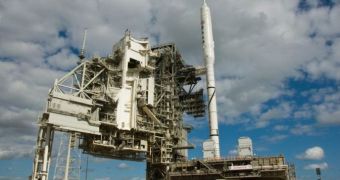According to a statement released by NASA officials yesterday, the new prototype ARES I-X rocket may not fly on Tuesday after all, if the weather over the Kennedy Space Center, in Cape Canaveral, Florida, does not clear up. After a number of delays and aborted test flights, the spacecraft, the first new delivery system that the American space agency created in over 25 years, was rolled out to its Launch Pad 39B on October 20. Having troubleshooted the last glitches on the way there, engineers and mission planners are hopeful that they will be able to launch the suborbital test flight on time.
The goal of the flight is to assess the integrity and functionality of the first stage motor, and also to determine if the separation system between the first and second stages is working properly. A number of ground-based systems will also be tested, as well as the operations associated with them. The craft, which is a precursor of the ARES I rocket – that will fly the Orion Crew Exploration Vehicle to low-Earth orbit –, is also outfitted with a bogus second stage and payloads, so that the test mimics the actual launch conditions for ARES I as faithfully as possible, Space reports.
“Our weather on Tuesday is going to be a little bit of a problem. I feel more optimistic about Wednesday than Tuesday,” weather officer Kathy Winters said yesterday. Regardless of the test-flight results, the information and telemetry collected by teams on the ground and in tracking stations will provide much-needed guidelines about how to modify ARES I for optimum performances. “It's very significant data that is going to be very instructive to us since we haven't done this in a long time,” NASA Exploration Systems Mission Directorate Associate Administrator Doug Cooke said on Friday.
The weather conditions needed for the new ARES I-X launch are a lot more drastic than those needed to launch the space shuttles atop their external fuel tanks. A phenomenon known as “tribo electrification” poses a lot of threats to the new rocket. As it climbs through clouds, the friction force causes electrical charges to build up, which can severely affect the electronic navigational systems aboard the rocket. Previous test flights have proven that the space shuttles are immune to this risk, having already been constructed so as to defeat this danger.

 14 DAY TRIAL //
14 DAY TRIAL //